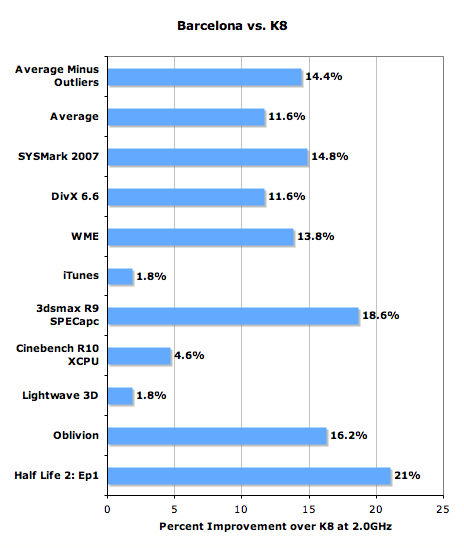AMD Phenom Preview: Barcelona Desktop Benchmarks
by Anand Lal Shimpi on September 10, 2007 12:03 AM EST- Posted in
- CPUs
K8 vs. Barcelona: The Phenom Preview
With the test methodology explained, how does Barcelona stack up to a pair of dual-core Opterons? In other words, how much faster can we expect Phenom to be vs. the Athlon 64 X2? To put it succinctly, it looks like around 15% clock for clock:

Clock for clock there's nothing short of a huge increase in performance over the K8 based Opterons in SYSMark 2007. The E-Learning and Video Creation tests are both around the 20% mark, while 3D rendering drops to a 12% advantage, but the productivity suite sees almost a 30% increase in performance thanks to Barcelona. The overall improvement in SYSMark 2007 ends up being 15%.
In fact, the average performance improvement of Barcelona over K8 ends up being 11.5% and 14.3% if we exclude the two 1.8% outliers in our data.
Johan's article showed that Barcelona in the enterprise world is competitive, but on the desktop our data indicates that AMD won't be upsetting Intel anytime soon. Even at 2.6GHz, a 15% boost in overall performance won't be enough to dethrone Intel, but with competitive pricing AMD could actually be a real alternative again.
We have no idea how AMD will price Phenom, but as we suspected, it may be the pricing that ends up deciding how competitive Phenom is.










70 Comments
View All Comments
MadBoris - Monday, September 10, 2007 - link
hmm, especially if it is only @cas5, as mentioned above.It will be interesting to see if it yields anything more than just a few percent, as to scaling, and if benefits compound per socket.
As to one socket and 4 cores I don't really envision it being that much more than a few percent, but then again, I'm not investing any thought or speculation to try and figure out what will be answered when it actually matters and HW is available.
Major point for me is, being able to OC a q6600($280) to 3.2GHz - 3.4GHz on air is going to be real stiff competition for AMD's Phenom, as to my purchasing decisions, which is all I am concerned about mainly.
Also I believe all peoples talk about "true" quad is going to fall a bit flat for the majority of applications/games in real world comparisons with Kentsfield. Because already anyone that is interested to research it can see that the cache/bus penalties in scaling from 2 to 4 cores is basically nonexistent on applications that actually 'fully leverage' all 4 cores. Some apps will benefit, but I expect this to come to light before long and people will see that the penalty of 2 cores in one (Intel Quad), was more speculation, than actual reality, for 'most' consumer applications and games.
I do like AMD's advances but we seriously need more frequency, CPI cannot be overlooked.
duploxxx - Monday, September 10, 2007 - link
if AMD is already able to show multiple phenom systems on 3.0GHZ without dditional cooling (just boxed heatpipe cooler) then i wouldn't be too worried about oc performance of k10ilkhan - Monday, September 10, 2007 - link
15% over K8 is not going to be enough if it launches at (or at least doesn't overclock easily to) 3.2Ghz. At the 2.5 indicated here, yorkfield@3.2+ is going to eat agena for lunch, while being more profitable for intel than agena can hope to be for AMD.Pity.
JackPack - Monday, September 10, 2007 - link
Based on these numbers, consumers are likely going to stick with Intel quads.Clock for clock, Kentsfield was often >30% faster than Quad FX. Barcelona being 15% faster than K8 is reasonable but it's clearly not going to touch Penryn/Yorkfield.
duploxxx - Monday, September 10, 2007 - link
Alltough it is nice to see what anand tried to put here on electronic paper. I can't be compared to the real phenom in a few months.If you want to know why, check Anand's memory review of a year a go and check how well k8 and also k10 is scaling with better/faster memory.
in a barcelona rig you have reg 667@cas5.
so people who are already making conclusions on these benches, one reply: too early.
JackPack - Monday, September 10, 2007 - link
This isn't K8 though. The L3 in Barcelona is going to make it less sensitive to memory bandwidth and latency.Regs - Monday, September 10, 2007 - link
Memory hits and misses (latency) have nothing to do with the L3. The L3 is there as a buffer for the information being proportion to the 4 cores.JackPack - Monday, September 10, 2007 - link
Look up the term "memory hierarchy."Regs - Tuesday, September 11, 2007 - link
what do you think pulls the data into the L3? God?JackPack - Tuesday, September 11, 2007 - link
It's called prefetching. The data is in the L3 before the CPU needs it, reducing memory traffic and latency.Not only that, but Barcelona has a L3 latency of 20ns. To get data from the main memory, it has to go through all levels of cache. When you look at the cumulative latency of the memory hierarchy, the one or two cycle penalty of RDDR2 is trivial.